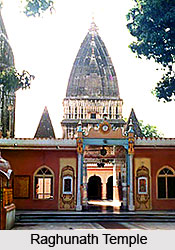 Raghunath Temple, with seven shrines each with its own `Shikhara`, (shikhara, a Sanskrit word translating literally to `mountain peak`, refers to the rising tower in the Hindu temple architecture in north India) is one of the largest temple complexes of north India, located in Jammu city. Maharaja Gulab Singh and his son Maharaj Ranbir Singh built the temple, during the period of 1853-1860. The temple has many gods enshrined, but the presiding deity is Lord Ram, an `avatar` (incarnation) of Lord Vishnu. The temple came under public glare and intense scan, when in November 24, 2002, while the Hindus were performing puja in the complex, the `fidayeen` (suicide tactic used by militants) terrorist attack took place, resulting in at least 10 deaths, injuring several devotees.
Raghunath Temple, with seven shrines each with its own `Shikhara`, (shikhara, a Sanskrit word translating literally to `mountain peak`, refers to the rising tower in the Hindu temple architecture in north India) is one of the largest temple complexes of north India, located in Jammu city. Maharaja Gulab Singh and his son Maharaj Ranbir Singh built the temple, during the period of 1853-1860. The temple has many gods enshrined, but the presiding deity is Lord Ram, an `avatar` (incarnation) of Lord Vishnu. The temple came under public glare and intense scan, when in November 24, 2002, while the Hindus were performing puja in the complex, the `fidayeen` (suicide tactic used by militants) terrorist attack took place, resulting in at least 10 deaths, injuring several devotees.
The gigantic Raghunath temple has seven lofty `shikharas`, where every shrine has its own shikhar. On the very entrance to the temple, a portrait of Maharana Ranbir Singh and an image of Lord Hanuman exaggerate the site. The centrals shrine is dedicated to Lord Ram/Raghunath, who is the commanding deity. Apart from the main shrine, the other shrines encompass various incarnations of Lord Vishnu. There is another remarkable shrine of Lord Surya (Sun God), which houses different forms of the Lord. Inside the temple there are other shrines that house colossal statues of the Hindu gods and goddesses. It is notable to mention here that gold sheets envelop the interior walls on three sides of the temple. It also has a gallery, where various `lingams` (phallic form of Lord Shiva) and `saligrams` are placed. Raghunath temple comprises almost all the images of the Hindu Pantheon, an unusual embodiment in temple architecture. Sermons and rituals of the temple include both morning and evening aarti.
Glimpses of Mughal masonry can be visualised in the architectural splendor of Raghunath Temple. The carvings and arches being extraordinarily resplendent, grabs everyone`s attention. There is a library in the temple complex, housing rare Sanskrit books and manuscripts. People visit this temple in large numbers to pay their homage to the deity and seek blessings from the Lord.





















